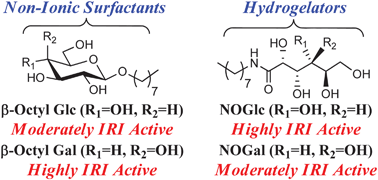Potent inhibition of ice recrystallization by low molecular weight carbohydrate-based surfactants and hydrogelators†
Abstract
Ice recrystallization inhibition (

* Corresponding authors
a
Department of Chemistry, University of Ottawa, 10 Marie Curie, Ottawa, Ontario, Canada
E-mail:
robert.ben@uottawa.ca
Fax: +613-562-5170
Tel: +613-562-5800
b Department of Physics, University of Ottawa, 150 Louis Pasteur, Ottawa, Ontario
c Centre for Catalysis Research and Innovation, University of Ottawa, 30 Marie Curie, Ottawa, Ontario
Ice recrystallization inhibition (

 Please wait while we load your content...
Something went wrong. Try again?
Please wait while we load your content...
Something went wrong. Try again?
C. J. Capicciotti, M. Leclère, F. A. Perras, D. L. Bryce, H. Paulin, J. Harden, Y. Liu and R. N. Ben, Chem. Sci., 2012, 3, 1408 DOI: 10.1039/C2SC00885H
To request permission to reproduce material from this article, please go to the Copyright Clearance Center request page.
If you are an author contributing to an RSC publication, you do not need to request permission provided correct acknowledgement is given.
If you are the author of this article, you do not need to request permission to reproduce figures and diagrams provided correct acknowledgement is given. If you want to reproduce the whole article in a third-party publication (excluding your thesis/dissertation for which permission is not required) please go to the Copyright Clearance Center request page.
Read more about how to correctly acknowledge RSC content.
 Fetching data from CrossRef.
Fetching data from CrossRef.
This may take some time to load.
Loading related content
